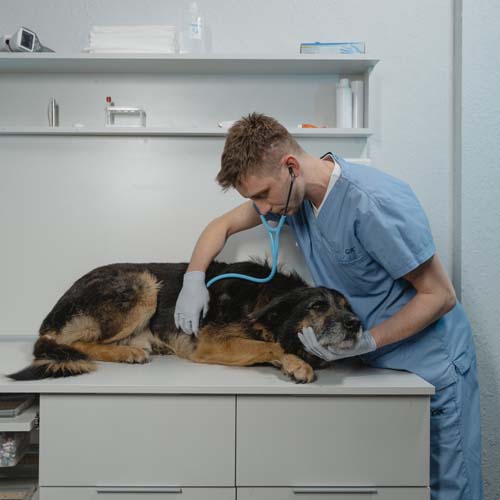When most people first get a new puppy, rescue or adopt a dog, they think of all the fun moments they will have with their new member of the family. But there are occasionally things that aren’t as enjoyable that we as current or future dog owners must consider when keeping our furry friends healthy and happy. These are collecting urine samples, stool samples and taking care of your pet dog’s anal glands.
Collecting Urine Samples From Your Dog
For example, sometimes when you go to the veterinarian, your doctor may ask that you to bring along a urine sample from your dog. For most, the first thing that goes through our mind is, how do I obtain this sample? I’ve found the simplest way to complete this task is to tape a small plastic container to the end of a long stick. In the past, I’ve used an old yogurt or cream cheese container, just make the sure the container is clean and firmly taped to the stick. As for the stick, I find a yard stick is best, these can be purchased from most dollar stores. When you take your dog out for a walk, position the container underneath their urine stream. This is easier to do with male dogs rather than female dogs but generally you can obtain a urine sample within a couple tries.
The veterinarian will want as fresh a urine sample as possible so try to collect the sample just prior to the appointment. If you will unable to get the sample immediately prior to the appointment, make sure to keep the urine sample refrigerated. The veterinarian will check your dog’s urine sample for a variety of things, including:
- Diabetes
- Kidney failure
- Infection
- Urine-specific gravity (how well your dog is concentrating their urine)
- pH (certain pH levels can indicate infection or other problems)
- Ketones (sometimes seen in cases of diabetes or body-wasting)
- Glucose (sugar in the urine, usually a sign of diabetes)
- Bilirubin (a breakdown product of blood)
- Blood
- Cystine crystals
These tests are used to detect diseases and illnesses that can range from common minor issues to major critical concerns. Urine samples are also commonly used for dogs prior to having an operation requiring anesthesia.
If you suspect your dog is experiencing any health issues, it’s important to consult with your veterinarian to determine the best course of action.
More common occurrences are bacteria and crystals. If bacteria are found, this could mean that your dog has a urinary tract infection, and your veterinarian will generally put your dog on antibiotics. With crystals, they can form in the urine whenever minerals bind together. A common treatment for crystals a specialized prescription diet.
Why Are Stool Samples Collected For My Dog?
At times your veterinarian may ask for a stool sample. The main reasons they ask for a stool sample from your dog or puppy is to determine if they have intestinal parasites such as:
- Roundworms,
- Hookworms,
- Whipworms,
- Coccidia,
- and Giardia
These parasites live in the dog’s gastrointestinal tract and fecal stool tests are a standard way of determining this. Stool sample tests in veterinary clinics and are recommended at least once a year.
If you suspect your dog is experiencing any digestive issues, it’s important to consult with your veterinarian to determine the best course of action.
Dogs can get these intestinal parasites by eating fecal matter from another affected animal. You will need to bring in a fresh sample to your veterinarian’s office. The doctor will then look at it under the microscope for signs of eggs. The most common from the above list are roundworms, hookworms, whipworms, and tapeworms. Most of the popular monthly heartworm medications protect against roundworms and hookworms. If you live in a rural area or your dog spends a lot of time outside, they may need to be treated on a quarterly basis. Other diseases like coccidia, can also be seen under the microscope from your dog’s stool sample.
Taking Care Of Your Dog’s Anal Glands
What are anal glands? Anal glands are small sacs located on either side of your dog’s anus that produce a foul-smelling fluid. Taking care of your dog’s anal glands is an important part of their overall health. Most of the time, your dog will empty their own glands while defecating. However, in some dog breeds, the anal glands do not empty properly and require more attention. Here are some tips to help you take care of your dog’s anal glands:
- Regularly check your dog’s anal glands: Check for any signs of swelling, redness, or discharge. If you notice any of these symptoms, contact your veterinarian.
- Provide a high-fiber diet: A high-fiber diet consisting of quality pet food can help regulate your dog’s bowel movements and promote healthy anal gland function.
- Express the anal glands: If your dog is experiencing discomfort or has a history of anal gland problems, you may need to express their anal glands manually. This can be done by a veterinarian or groomer, or you can learn to do it yourself with the help of a veterinary technician.
- Keep the area clean: Regularly clean the area around your dog’s anus with a mild soap and warm water to prevent infection.
If you suspect your dog is experiencing any health issues related to their anal glands, it’s important to consult with your veterinarian to determine the best course of action. Make an appointment with your veterinarian. They will check the anal glands and if they are full, will manually empty them. You can learn how to do this yourself at home as some dog breeds require more frequent manually emptying.




